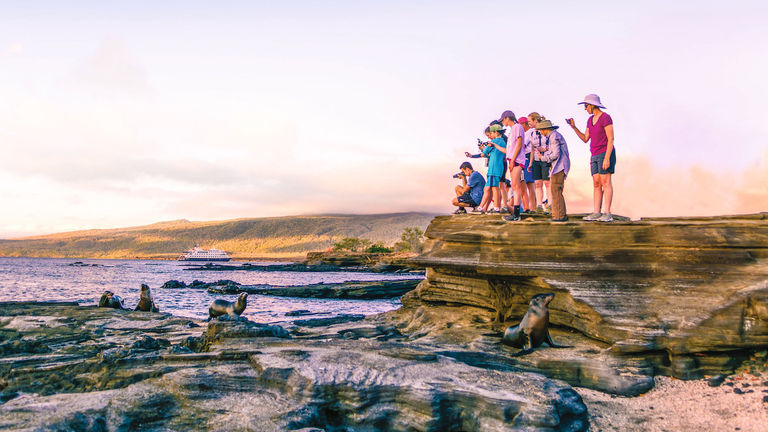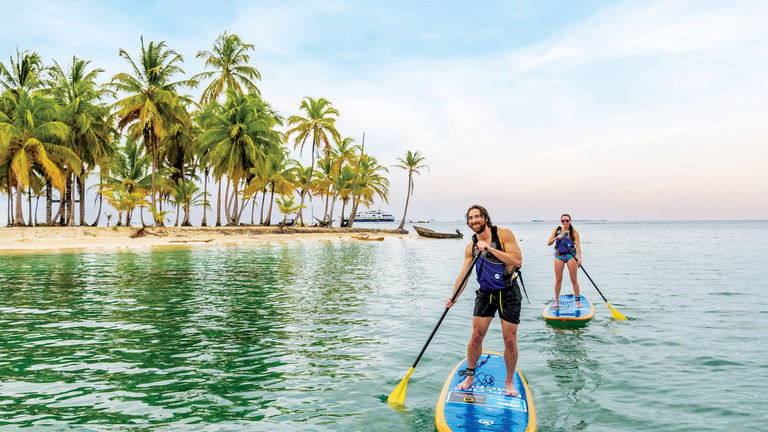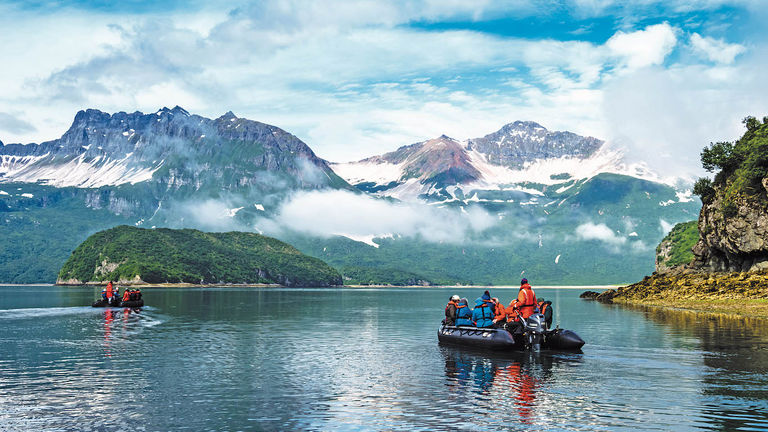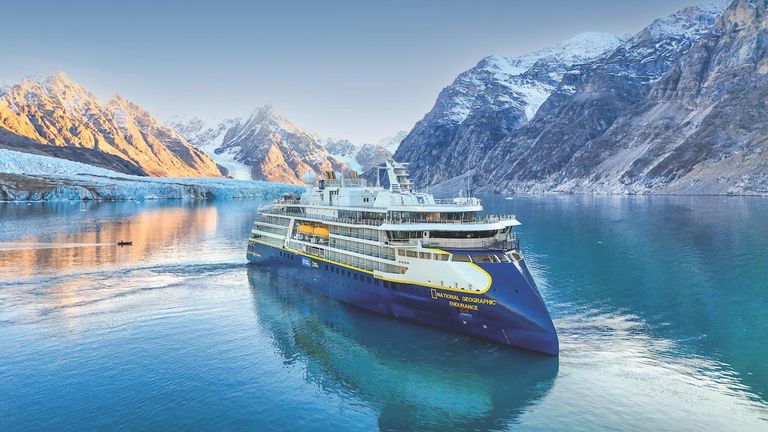At first glance, the concepts of sustainability and luxury travel may seem rather unrelated. But, as demand for upscale experiences with an eco-friendly approach continues to grow, travel advisors are finding new ways to satisfy big-budget clients.
The increased demand for sustainable travel has been documented in numerous studies. According to a recent report by global strategy consulting firm Simon Kucher, for example, it’s one of this year’s top travel industry trends.
The luxury sector is proving to be a powerful driver of sustainable travel bookings. A recent survey of Virtuoso travelers, in fact, found that 59 percent of respondents are willing to spend more on responsible travel when they understand how the funds are being used. And that’s not all: 26 percent of Virtuoso advisors say their clients are committed to reducing their carbon footprint by supporting carbon offsetting initiatives.
“In luxury travel, sustainability is evolving from a desirable extra to an essential expectation,” says Duncan Greenfield-Turk, chief travel designer and CEO of Global Travel Moments. “For me, true sustainability goes far beyond eliminating single-use plastics or offering local cuisine. It means that if a hotel, resort or operator were to pull out of a destination tomorrow, the local environment, community and economy would be better off for they’re having been there. That’s the gold standard.”
Jennifer Evans, president and owner of Aura Travel, an Affluent Traveler Collection affiliate, agrees about the growing importance of environmentally conscious upscale travel. “In the luxury travel segment, sustainability won’t be just a trend — it’s the new definition of luxury,” she says. “Today’s higher-end travelers are wanting more than just comfort. They want meaningful, responsible experiences that give back to local communities and protect the environment. The future of luxury travel isn’t just about where you go but how you go, and the legacy you leave behind. It’s not a limitation, but a deeper, richer layer of the travel experience.”
 Courtesy of: National Geographic-Lindblad Expeditions
Courtesy of: National Geographic-Lindblad Expeditions
Credit: Socrates TomalaA Shift in the Upscale Mindset
The rise of sustainable luxury travel isn’t the result of some grand marketing scheme. It’s fueled by the travelers themselves, according to Jared Benoff, CEO, Vacationeeze, a TRAVELSAVERS affiliate.
“More and more, clients are asking about wellness and sustainability, as they want to spend their time in a thoughtful way, especially in the luxury segment,” Benoff says. “Clients are asking more direct, specific questions about slow travel and single-use plastics. We're seeing an increased interest in sustainability across a huge range of clients, including at all-inclusive resorts. We're also seeing this in the luxury cruise and river cruise segment, as clients are aware of the transportation impacts and potential food waste. These clients understand the impact of these vessels and want to know how the cruise lines are offsetting their impact both at the macro and micro scale.”
Greenfield-Turk says there are multiple reasons for increased environmental awareness among big-budget travelers. “It’s both values-driven and experience-driven,” he explains. “Today’s luxury clients are incredibly savvy. They’re seeking out properties and itineraries that align with their principles but also with their desire for connection and authenticity. Many have seen firsthand the effects of climate change or overtourism and want to make choices that reflect a more responsible mindset. The interest is being driven by a combination of education, lifestyle evolution and a deeper desire to give back to the places they visit. It is also being driven by their children and their children’s children.”
Educating Clients and Enhancing Experiences
Effectively positioning the concept of luxury travel within the framework of sustainability logically paves the way for more sales, notes Greenfield-Turk. “We don’t position sustainability as a limitation,” he says. “We present it as an enhancement and, wherever possible, as an inherent part of every itinerary. From zero-waste fine dining to luxury lodges built with reclaimed materials that blend seamlessly into their natural surroundings, we show clients that true luxury now includes a sense of responsibility and integrity. It’s not about compromise. It’s about conscious indulgence.”
Evans is also careful about taking the right approach. “We present it as an added layer of value,” she says. “If our clients are showing interest, we are showing them that they can enjoy indulgent, top-notch experiences and still make a positive impact. It’s not about sacrificing comfort, but about choosing options that are both luxurious and responsible. Clients don’t always come in asking for sustainability, so there is definitely an educational component.”
Joshua Harrell, chief marketing officer at WorldVia Travel Group, stressed the importance of qualifying clients to ensure the best fit. “People want the indulgences that come with luxury travel, but they also want to feel good about these decisions,” he says. “It’s incumbent upon advisors to understand these clients and what matters most to them — whether that’s sustainability or something else.”
 Courtesy of: National Geographic-Lindblad Expeditions
Courtesy of: National Geographic-Lindblad Expeditions
Credit: David VargasVetting Sustainable Suppliers
Finding appropriate partners and suppliers is a standard part of any travel advisor’s job, and it’s especially important when it comes to blending top-of-the-line travel experiences with socially and environmentally responsible practices.
“We build relationships with partners who understand that environmental responsibility and exceptional service are not mutually exclusive,” says Greenfield-Turk. “We dig deeper than the glossy marketing and ask hard questions about local hiring, conservation efforts, waste management and long-term community engagement. It comes back to my core belief: True sustainability means the destination thrives because of the supplier’s presence. Thankfully, through our affiliation with Global Travel Collection and membership in Virtuoso as well as IGLTA, we have access to suppliers that meet both sustainability goals and the highest standards of luxury.”
Evans added that while sourcing sustainable luxury suppliers is still a work in progress, advisors are making progress. “Sourcing eco-friendly suppliers in the luxury space is a learning curve, especially when it comes to maintaining the high standards our clients expect,” she explains. “Right now, it’s about building relationships with partners who are genuinely committed to sustainability and understand what a luxury experience looks like. We're constantly researching, asking questions and adapting as we go. It's not always perfect or easy, and options can be limited in certain destinations, but the goal is to find that sweet spot where eco-consciousness and exceptional service meet.”
Harrell’s company is also focused on making connections to support and grow this segment. “At WorldVia, we’re committed to strengthening our relationships with eco-friendly suppliers while keeping the expectations of our advisors’ clients top of mind,” he says. “This ensures that, when it’s time to sell, advisors have a well-rounded portfolio of products they can market, sell and book with confidence.”
 Courtesy of: National Geographic-Lindblad Expeditions
Courtesy of: National Geographic-Lindblad Expeditions
Credit: Ralph Lee HopkinsComplementary Concepts
As the preferences of luxury travelers continues to evolve, sustainability will likely play an even greater role in enhancing the client experience, according to Greenfield-Turk. “Luxury and sustainability don’t just coexist — they elevate each other,” he says. “For me, the most luxurious experiences are those that leave a lasting impression and a positive impact. When travel becomes a force for good, everybody wins.”
Evans aims to foster a deeper definition of upscale travel as she sells to high-end clients. “True luxury is about intentional, meaningful experiences,” she says. “When you stay at a stunning resort that supports its local community or enjoy a five-star meal made with locally sourced ingredients, you’re not sacrificing luxury — you’re deepening it. Sustainability adds value, story and soul to the journey, which is what the modern luxury traveler is looking for.”
Harrell noted that luxury travel suppliers are often better positioned to incorporate sustainable practices than other companies. “Because luxury suppliers often have a narrower focus, they can clearly define the ins and outs of their product offerings,” he explains. “That means that sustainability can be baked into their core ideals and the way they develop their product and, as a result, match the expectations of travelers looking for that approach in the trips that they take.”
Benoff is encouraged by the progress he’s seen in the market segment. “Luxury and sustainability do not need to be mutually exclusive,” he says. “The best options put sustainability at the forefront and make it easy to showcase their efforts, whether that's carbon offsets, food waste reduction, etc. It's a positive trend to see how many resorts and brands in the space are leaning in to make a real impact and combine luxury and sustainability in a meaningful way, without sacrificing the guest experience.”
 Courtesy of: National Geographic-Lindblad Expeditions
Courtesy of: National Geographic-Lindblad Expeditions
Credit: Rui SeabraNational Geographic-Lindblad Expeditions Charts a Sustainable Course for Luxury Travel
For National Geographic-Lindblad Expeditions, sustainability is much more than a marketing trend — it’s the foundation of the brand’s identity, according to Kathi Riddle, senior vice president, sales at National Geographic–Lindblad Expeditions.
“Lars-Eric Lindblad started Lindblad Travel in 1958 with the fervent belief that travel was an enormous opportunity to expose people to the beauty and wonder of the world through immersive, transformative experiences, so that they might think differently about the planet and our role in protecting it,” she explains.
The founder’s son, Sven-Olof Lindblad, carried that belief forward and today — as the global operator and seller of the National Geographic–Lindblad Expeditions co-brand — the company continues to connect travelers with planet-friendly experiences around the globe.
According to Riddle, the National-Geographic-Lindblad Expeditions approach is grounded in three pillars of responsible exploration: conservation and environment, community and culture, and science and education. “This ethos permeates across our ship design, the onboard experience and our shoreside operations,” she says.
Lindblad’s vessels are built to minimize environmental impact while offering the comforts of high-end travel. “While travelers will of course marvel at the exterior design of our environmentally centric, mission-built ships, National Geographic-Lindblad Expeditions invites guests in to see the core of its onboard experience: the culinary elements.” The company’s gastronomic approach includes sustainably and locally sourced ingredients as well as zero-waste strategies such as plated meals and limited buffets.
Riddle emphasizes that sustainability and luxury are not mutually exclusive. “By default, sustainable travel necessitates a smaller, more intimate scale to be eco-friendly,” she explains. “That means more opportunities for guests to learn directly from experts, connect with local communities, encounter wildlife in their natural habitats and enjoy comfortable, quality accommodations in beautiful natural settings.”
To help travel advisors speak confidently about sustainable travel, National Geographic-Lindblad Expeditions offers tools like the Expedition 360° online training platform. “Not only does it offer valuable insight into how we incorporate sustainable concepts into everything we do, but it also includes sales enablement tools such as brochures, fact sheets, and Approach Guides content experiences to share with and inspire their clients,” Riddle notes. “Of course, our team of Regional Sales Directors are an invaluable resource and are available to answer questions, provide guidance and help close sales.”
“Travel advisors should remember that at the end of the day, talking about sustainability is more of an art than a science,” Riddle adds. “And any conversation that includes sustainable travel is a good conversation!”